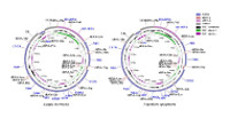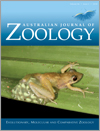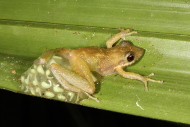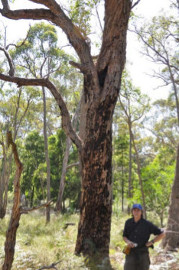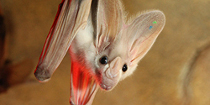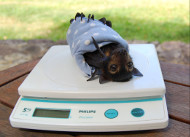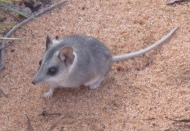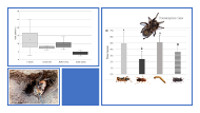Australian Journal of Zoology
Volume 66
Number 3 2018
Family-level phylogenetic relationships of the superfamily Sylvioidea have always been debated and the mitogenome data have a high probability of resolving intractable phylogenetic relationships. On the basis of mitogenome data, the family-level phylogenetic relationships ((((Pellorneidae, Leiothrichidae) Timaliidae) Zosteropidae) Sylviidae) among the superfamily Sylvioidea were strongly supported and Spizixos semitorques was nested within the genus Pycnonotus. We propose that the generic placement of Spizixos should be reconsidered.
We tested a threatened frog at Cape Melville for chytrid infection and assessed other Cape York data. Our results suggest frogs on Cape York have been spared chytridiomycosis thus far. We discuss how the disease could spread there, what can be done to reduce risk, and an emergency procedure should it be introduced.
Photo by Conrad Hoskin.
Effective management of tree-hollow dependent wildlife is enhanced by detailed knowledge of the trees used for shelter and breeding. We describe the characteristics of 52 den trees and hollows (cavities) used by the yellow-bellied glider (Petaurus australis) in the south-west of its geographic range.
Photo by S. M. Carthew.
We investigated the behaviour and movement patterns of eel-tailed catfish, Tandanus tandanus, using acoustic telemetry in an unregulated subtropical river. Generally, fish undertook inter-pool movements under low flow conditions; however, the greatest movement response was detected during the first post-winter flow event. Results can assist conservation and management of endangered populations in south-eastern Australia.
Photo by Queensland Department of Agriculture and Fisheries.
Ghost bats (Macroderma gigas) are a rare, sparsely distributed species from northern Australia. Knowledge of their diet is limited to a few older studies and serendipitous observations from field monitoring of prey species. This study used analysis of dried food remains and DNA metabarcoding to identify 32 new prey species consumed by ghost bats in the Pilbara region of Western Australia, 19 of which had not previously been reported from any other part of Australia.
Photo by Perth Zoo.
This study was based in a wildlife care facility and was designed to estimate post-natal growth rates in, and develop a milk feeding chart for, infant spectacled flying-foxes, a species regarded as vulnerable. Forearm length increased by 0.55 mm and body mass by 1.5 g per day; growth rates varied by year. The study highlights that data collected by wildlife carers can be a source of otherwise hard-to-obtain information.
Photo by Tolga Bat Rescue and Research Inc.
The endangered sandhill dunnart is known from three populations in southern Australia. Genetic connectivity and genetic diversity were investigated across the species distribution and at a fine-scale within one population. Analyses revealed limited phylogeographic structure within the species and no genetic structure or sex-biased dispersal within one study site. The findings highlight the high mobility of Australian arid small mammals and the importance of landscape connectivity to enable animals to track resource pulses and maintain genetic diversity.
Photo by Amanda L. McLean.
We studied the feeding parameters of Grammostola vachoni, a threatened Theraphosidae spider, endemic to the mountain systems of central Argentina. The knowledge of trophic traits is important for understanding animal ecology, and the contribution to the ecosystem that G. vachoni has as a predator, combined with potential threats of habitat make it necessary to obtain biological information to support its conservation. Therefore, this study contributes to the basic knowledge of the ecology of this tarantula.
